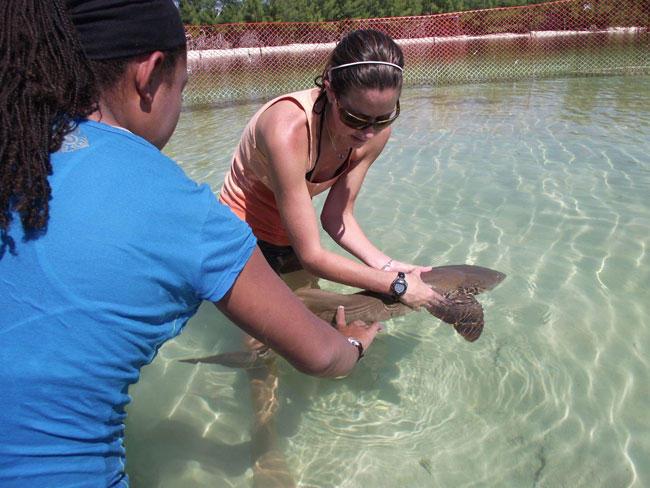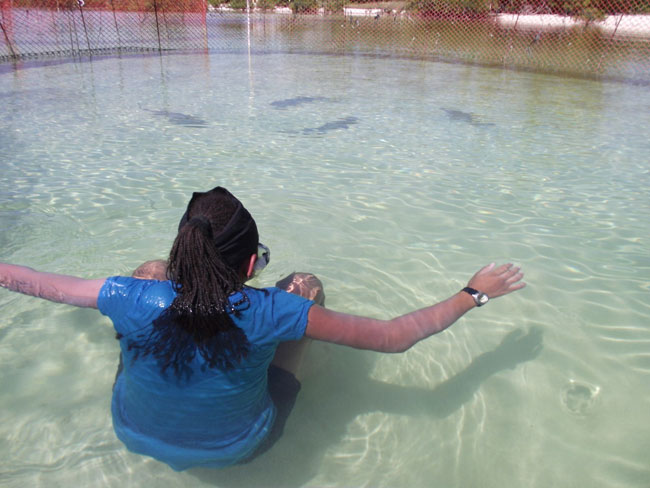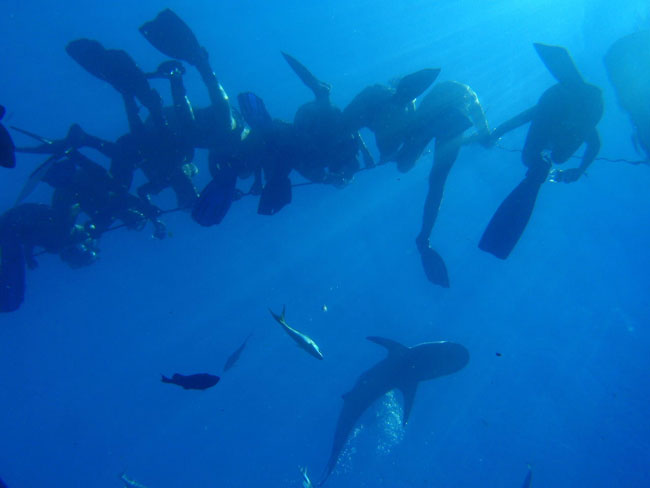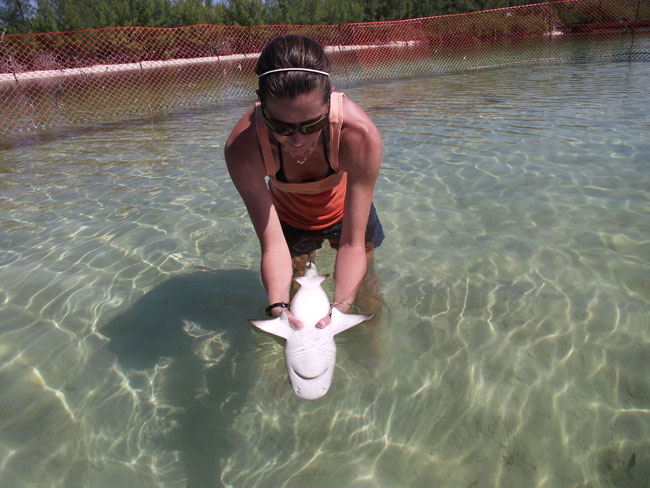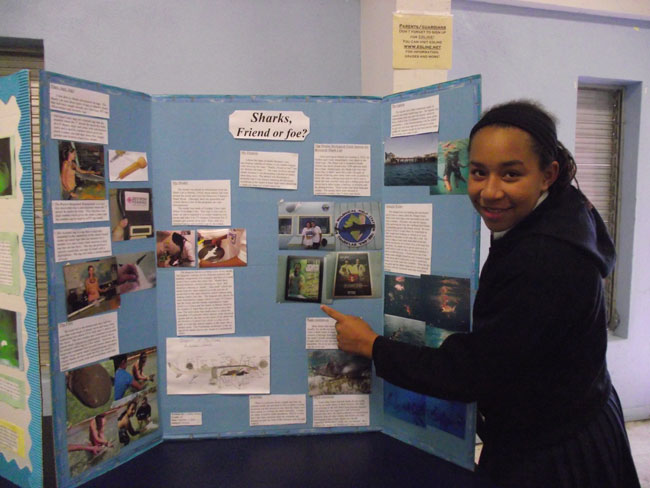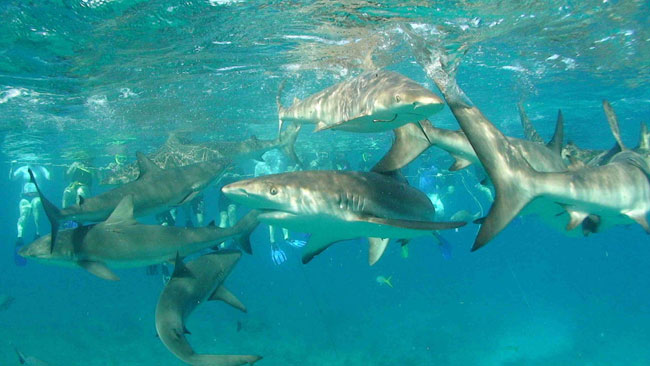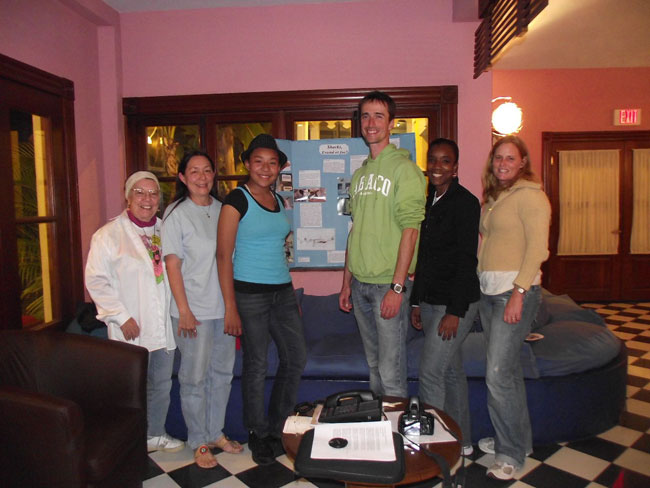|
From:TheBahamasWeekly.com Grand Bahama
Grand Bahama Island, The Bahamas - It was July, 2010 and Shark Week on Discovery Channel was showing gory programmes on endangered sharks as well as a few science-based documentaries. An impressionable 12 year old student, my daughter Candice Woon was watching many of the programmes.
In August we were fortunate
to be able to stay at the lovely eco-resort, Paradise Cove. The
first day we took advantage of many of the amenities, snorkeling, kayaking,
the great food, a great day. On day two, I wanted to snorkel and
kayak again with my daughter. She did not wish to. It turns
out that the night before she had had a nightmare inspired by Discovery
Channel’s Shark Week about the giant extinct megatooth shark called
megalodon. So I told her that I would go snorkeling by myself
but she said no she would come with me to “protect” me.
In the end we snorkeled briefly but did not go kayaking.
After the snorkel while waiting
for the delicious lunch, Candice said, “Mom, I see a fin.” I said,
“ No! really? Where?.” She said, “Yes, right there”,
and pointed. Sure enough there was a small shark slowly meandering
along in shallow water where we had been snorkeling. We approached
one of the guides who told us it was a harmless nurse shark. He
said, “They have tiny teeth.”
That evening when we returned
home to Freeport, Candice was upset thinking that she had disappointed
me. I had hoped since she was 12 now she might be interested in
learning to scuba dive. But I was most upset with the Discovery
Channel and considered writing them a letter telling them how angry
I was with Shark Week frightening children
with gory shark attack programmes.
Meanwhile the Bishop Michael
Eldon School’s Science Fair was approaching in September. Candice
and her teacher, Ms. Ellis agreed that she could do her project on Sharks.
I realized that this could be a “teachable moment” for Candice.
So I emailed my old friend, on Bimini, Dr. Samuel Gruber, world renowned
shark biologist. He consented to have us visit the Bimini Biological
Field Station Sharklab and arranged for the scientists to share their
research experiences with Candice for her Science Project. He
was certain that after time spent at the Sharklab Candice would get
over the phobia she had developed during Shark Week, (my main concern!).
We flew in to South Bimini on October 2nd and headed straight to the “Sharklab.” We were greeted by Tyler Clavelle, Assistant Manager and Emily Marcus, Lab Manager. Our adventure with sharks began by Emily showing us the 3 types of tags, (NOAA dart tags, PIT electronic tags and sonar tracking tags) used in their research. After that we went with Emily to the pens in shallow water behind the station where four juvenile lemon sharks and one juvenile nurse shark were swimming lazily in the corral . Then Emily caught one little lemon shark and Candice was allowed to feel its dermal denticles, tiny scales that cover the skin of all sharks. If you rub your hand in one direction it feels smooth and in the opposite direction it feels rough like sandpaper or when you rub crushed velvet the wrong way. Emily demonstrated how to put the lemon and nurse sharks into tonic immobility a trance-like state, a method that Dr. Gruber had discovered decades ago. Putting the shark to sleep like that is very helpful in handling them for research purposes. Following that Candice put on a face mask and sat in the pen to watch them gracefully swimming around as they carefully avoided the humans invading their space.
After lunch with the Sharklab volunteers, the entire group of young aspiring volunteer-scientists coming from all over the world got into boats and ran the 3 miles south to Triangle Rocks for a shark (snorkel) dive with Caribbean reef sharks. While the boats were being positioned the sharks started arriving in anticipation of a free lunch. Each person was fitted with a 2 lb weight belt to keep them vertical in the water column. We all held on to a rope attached to the boat and suspended by a red buoy to an anchor on the sea floor. We were shoulder to shoulder forming a human wall. Emily threw chunks of fish from the boat to the waiting reef sharks. Earlier during our briefing we were told if we felt a shark was coming too close to simply kick at it with our fins. Because sharks have very sensitive organs on their snout called ampullae of Lorenzini as well as the lateral line organ which can detect vibrations in the water, kicking ones fin toward a shark tends to surprise and frighten it away.
I was nervous. I had
done scuba shark dives before but in this instance we seemed a lot closer
to the action than I remembered. I kept asking Candice if she
was OK, but I think I was annoying her because she was perfectly fine,
paying attention to the sharks and kicking out when she felt the time
was right. At one point Candice saw a shark that seemed to be
heading toward her and she kicked it in the nose with her fin.
I heard Emily say, “Good one!”
After the sharks had eaten
their fill, the snorkelers left the rope to swim around, take photos
and watch the ones that were still hanging about. We then
moved on to snorkel on a wreck called the Sapona, a concrete streamer
that had run aground in the hurricane of ‘26.
The following day Jill Brooks, Assistant Manager, took us back to the pens and allowed us to hold the sharks while they were asleep in tonic immobility. Candice and I snorkeled in the pen with the juvenile lemon sharks and nurse shark then went on to tour the Nature Trail that was created by Grant Johnson and Katie Grudecki of the Bimini Sands resort. We were amazed to see lush examples of several healthy habitats. There was a huge termite nest, many lizards of various species, numerous birds, and native vegetation.
The highlight of this tour was to see and
handle the endemic and endangered Bimini Boa. It was beautifully
patterned and had an incredible iridescent sheen to it. Grant
has been instrumental in establishing a research project of this species
which is being intensively studied by visiting university scientists.
Thus far over 100 of them have been tagged. Grant explained how
they are beneficial to the environment of Bimini and that one of their
favourite foods is rodents. His efforts include educating residents
of North and South Bimini on the value of this species to Bimini especially
for keeping the rodent populations in check.
After returning home, Candice
prepared her Science Project on the sharks of Bimini and was chosen
to participate in the Bishop Michael Eldon School 2010 Science Fair.
We sent a photo of her hand-sculpted lemon shark (showing exterior of
a lemon shark and interior organs), presentation board and the report
to Dr. Gruber who was so impressed that he sent it to Matt Rand and
Jill Hepp of the Pew Trust’s Global Shark Conservation Group.
Mr. Rand is interested in the possibility of using the project in an upcoming educational campaign as part of an effort to create a national shark sanctuary in The Bahamas. According to Matt, shark populations are declining worldwide as at least 73 million are killed annually for their fins to be used in Chinese shark-fin soup. “Because of this outlandish luxury dish these creatures are being wiped off the planet,” Mr. Rand said.
The Pew Environment Group has
worked with governments around the world and was successful in encouraging
Palau and Maldives to establish the first ever sanctuaries for sharks
in their exclusive 200 mile economic zones.
Recently, James Mackey CEO
of Sunco Wholesale Seafood Ltd. announced in a local daily that he is
planning to expand his sea-cucumber export operation at Mastic Point,
North Andros to include the export of shark fins to Hong Kong.
Considering that The Bahamas is known to support some of the healthiest
populations of sharks in the ocean, conservationists throughout The
Bahamas and around the world reacted strongly and negatively to his
planned taking of fins for export.
The Pew Environment Group, The Nature Conservancy, BREEF, Friends of the Environment, EARTHCARE, The Bahamas Sea Turtle Conservation Group, the Bahamas Humane Society, reEarth, Tropic Sea Food, Envirologic Bahamas and the Bahamas National Trust are working hand in hand to educate the public about the value of living sharks to the health of reefs and flats and to our tourist-driven economy. The end result will be a better understanding of the role sharks play and why it is important to outlaw shark fishing and support the creation of a shark sanctuary in The Bahamas.
The reason why sharks thrive
in The Bahamas goes way back to 1993 when a 3-day sustained demonstration
organized by EARTHCARE, reEarth and Ocean Watch in Rawson Square in
front of the House of Assembly resulted in commercial long-line fishing
being banned by the then FNM Government. Prior to the ban over
20 long-line boats were going to be brought into the country from Canada.
The first of these, MV Kostakis already targeting sharks for the Asian
sharkfin market was videotaped harvesting sharks at a famous shark dive
site while horrified shark divers watched. The hew and cry from
the Bahamian people had the right effect—long-line fishing was quickly
banned by the government.
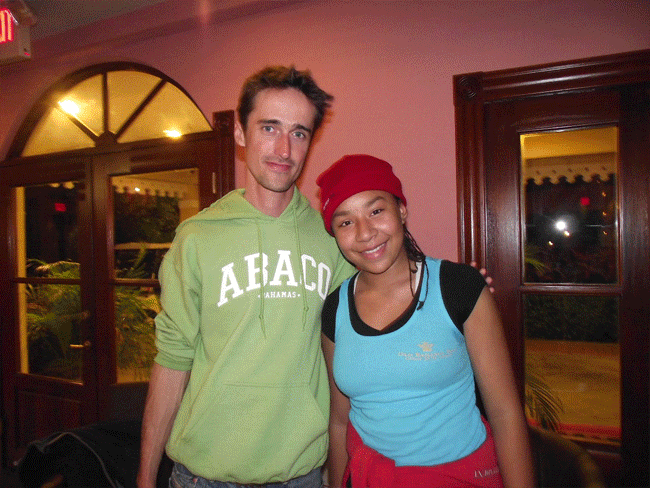 (SLIDE SHOW) Cousteau said that one of the highlights of his trip was meeting young Grand Bahama student Candace Woon. "There were some things about sharks that I did not know, and she explained them to me." ALL Photos courtesy of Gail Woon EDITORS NOTE: Pierre Cousteau was so taken with Candice and her in-depth project that he included mention of her when The Bahamas Weekly interviewed him a few days later. Read that article : A conversation with Pierre-Yves Cousteau MORE RELATED ARTICLES: (VIDEO) Shark Conservation in the Bahamas with the PEW Environment Group (VIDEO) Bahanmas National Trust pushing for amendment to Fisheries Act and shark conservation New Legislation Wanted For Shark Protection Shark dives bite off $78m tourism spend (Learn more about Shark Conservation)www.bnt.bs
|
